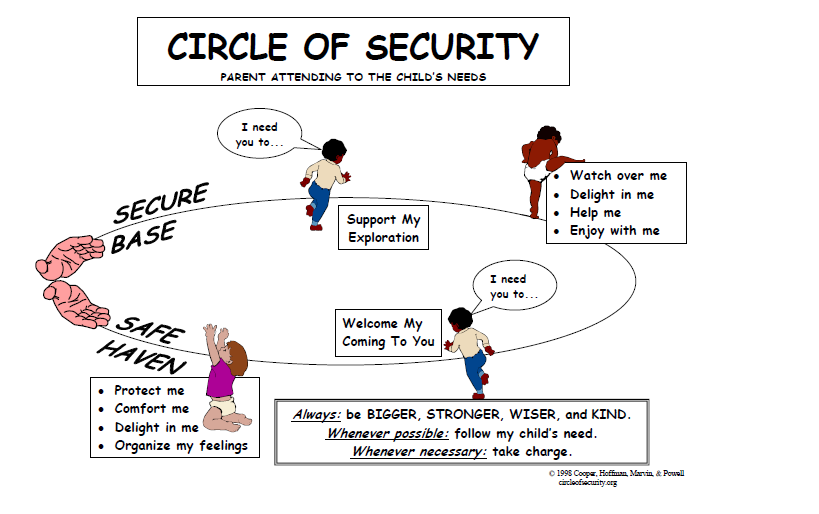Delighting In Your Child – Part 1 – A Look at Attachment
The concept of “attachment” has found its way into much writing and talking about parenting, but what does it mean, and more importantly, how can parents help their child to develop a secure attachment? Attachment is the lasting emotional bond that a child forms with a specific person that provides safety, comfort, soothing, and pleasure. This mother-child attachment bond shapes an infant’s brain, profoundly influencing their self-esteem, their expectations of others, and their ability to attract and maintain successful adult relationships
Almost all children will develop an attachment but the nature of attachment varies, depending largely upon the care-giving style of their parents. Children who are securely attached are more likely to be resilient under stress, have better relationships, and enter school ready to learn.
The Attachment Bond Shapes an Infant’s Brain
For better or worse, the infant brain is profoundly influenced by the attachment bond—a baby’s first love relationship. Research has found that when the primary caretaker can manage personal stress, calm the infant, communicate through emotion, share joy, and forgive easily, the young child’s nervous system becomes “securely attached.” The strong foundation of a secure attachment bond enables the child to be self-confident, trusting, hopeful, and comfortable in the face of conflict. As an adult, he or she will be flexible, creative, hopeful, and optimistic.
Our secure attachment bond shapes our abilities to:
- feel safe
- develop meaningful connections with others
- explore our world
- deal with stress
- balance emotions
- experience comfort and security
- make sense of our lives
- create positive memories and expectations of relationships
As you read through that description, I am sure that every one of you thought to yourself, “YES, I want THAT, for my child”. But how do I know that my child’s attachment to me is SECURE?
Drawing on attachment research a group of American psychotherapists have developed a user-friendly graphic illustrating the different needs children have of their parents, named the Circle of Security (COS) (Cooper, Hoffman, Marvin & Powell, 1998). When a child can move safely through the circle, it is indicative of a secure attachment with their parents. In this graphic the hands represent the parent, and the circle represents the child moving away to explore and coming back when necessary.
To develop a secure attachment, children require their parents to fulfill two key roles. Firstly (on the top half of the circle) the parent’s role is to be a secure base from which the child can move away and explore their world. Secondly, children need a safe haven to return to.
The Secure Base
Exploration: For a baby this may be subtle, looking away from mom as something catches their interest, for a toddler with new-found mobility, it may be more obvious! Our toddlers and preschoolers are always out exploring something! This is an important role as it is through exploration that a child’s learning occurs.
The important thing about exploration is that children are more likely to explore when they feel safe and look to their parents for cues that it is OK. We have all seen that child that is hesitant to explore, that clings to mom, rather than venture out. In fact, that might be your child. You may make excuses to your friends about your child being “just shy” or “slow to warm up”, but you can sense your child’s anxiety about leaving you. This has more to do with the child’s relationship with you than it does anything else. If you can understand what your child needs from you to feel safe to explore, it can make this transition easier.
There are several distinct needs that a child has while exploring.
- First, they need to know that you are watching over them. They need to know that you are managing their safety so that they can feel safe to explore. Think about the number of times your child turns back to you for a reassuring “you’re ok”, before continuing to explore.
- Sometimes they need help, ideally just enough to do the task themselves, without the parent taking over. This is called scaffolding.
- Third, Children need their parents to enjoy their adventures and achievements with them. These are the “You did it!” moments. Whether that be celebrating a first step or first time down the slide by themselves.
As parents, we understand these first three tasks fairly well: watch over them, help them, enjoy with them. That seems like basic stuff to many of us. But the child’s needs don’t stop there. And if this is all that you provide your child, you will raise a child who is focused on achievement, on pleasing others… a child with a fragile ego and poor attachments in their relationships. Why? Because you are missing an important piece. Because our job isn’t just to watch over, help when necessary and enjoy their accomplishments…
- But perhaps most significantly they also need to know that their parents delight in them, just for being who they are (as distinct from what they do) and experiencing lots of genuine delight is likely to lead to a secure attachment.
So how do we delight in our child as they are exploring? By focusing on WHO they are more than on WHAT they do. It was so timely this week that a friend shared an article on Facebook that was titled something like “6 words that will change your child’s life”. In this article the author spoke about how in multiple interviews with major athletes of all kinds about the role their parents played in their success one theme emerged. The most profound statement that these parents made to their children wasn’t an encouraging, “Great shot”, nor was it a correcting, “Hey you just need to tighten up your swing”. No, the most profound statement:
“I LOVE to watch you play.”
There it is. No pressure, no expectations. Just enjoyment of the child themselves.
My kids are involved in a LOT of activities: soccer, swim team, dance team, taekwondo and on and on the list goes and grows. At the end of every practice that I take my children to, their question is the same, “Were you watching?” But the real question isn’t just “Did I see”, but did I Enjoy… did I DELIGHT? When we delight in them, we can stop watching their skill, and start noticing the joy on their faces, the strain as they work through a task, the pain of a miss… we can empathize with their feelings and stay intimately in tune with them. We worry less about performance, and focus more on the amazing gift that is our child.
Delight In Your Child
Babies are actually “hard-wired” to experience joy with their caregivers in the early months of life. Researchers are finding that mutual joy is the basis for increased brain growth. Our children need to know, beyond a shadow of a doubt, that they give us JOY. What Delight communicates: I love YOU, I like YOU. My love and my like are not dependent on what you do (or don’t do).
Sometimes, as parents, we struggle to delight in our children, especially when they are exploring, because we are too focused on performance expectations. Sometimes we sit comparing them to other children and wish that they would be more… outgoing, athletic, focused, articulate, or less…serious, assertive, artsy, emotional.
Part of the challenge of delighting in our child is to delight in your child as an individual.
Try it today!






Leave a Reply
Want to join the discussion?Feel free to contribute!